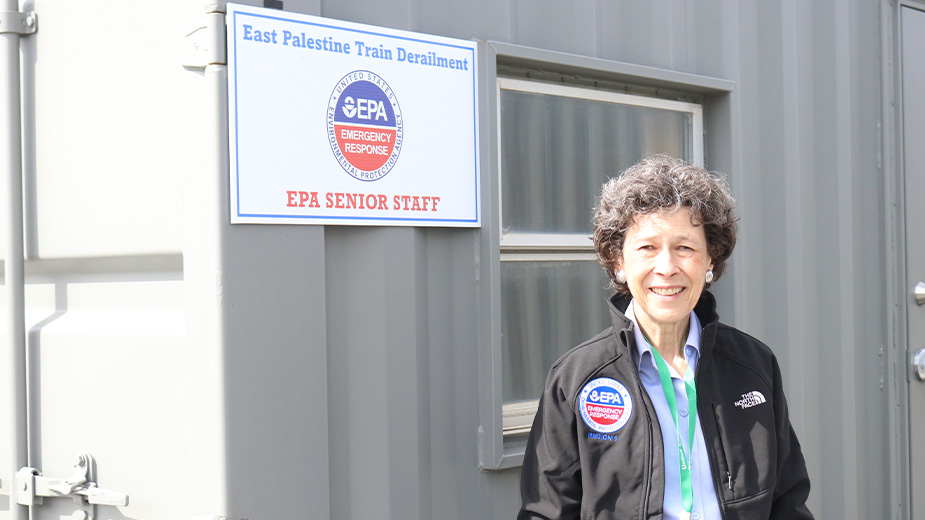EPA Official Addresses Derailment Challenges, Misinformation
EAST PALESTINE, Ohio – Concerns about the environmental effects of the train derailment in the village has been only one part of the equation for the past two months, according to Debra Shore, regional administrator of the U.S. EPA for Region 5, which includes six of the states around the Great Lakes.
“This is a complex and, in some ways, new kind of an emergency response,” Shore said. “Not only was it complex in that there were a number of these toxic chemicals and hazardous waste on the train that derailed, that spilled and some were burned off and right in a residential community, but we discovered that social media is playing a role in this emergency in ways that may not have been quite so evident as in the past.”
There are Facebook sites where those admitted to the group share their stories and concerns with others in the community. Additionally, some repost misinformation pieces, which have been created by some outside the community.
Shore said she learned about one website reportedly pushing out conspiracy stories about the train derailment and utilizing artificial intelligence to hide the source of the story. Additionally, she said The Guardian had a story about Russian bots creating East Palestine-related stories.
“Professional journalism has a system of fact checking and making sure your sources are reliable,” Shore said. “We don’t see that with some of the social media sites, so it doesn’t serve in understanding complex issues, nuanced issues and really tends to be a source of misinformation.”
Additionally, Shore said some outside agitators came to town and grabbed a microphone to talk about what happened.
To a community that just went through the pandemic, Shore notes there was already uncertainty in people’s lives and mistrust of the government.
“Then on top of that, East Palestine and the surrounding community is traumatized and victimized by this derailment, so there are all these layers of challenge,” Shore said.
Combating Challenges
To combat that, the EPA opened a Welcome Center on Market Street and has now issued three weekly newsletters to update residents, even skeptical ones, about the progress and how to obtain resources as they deal with the hurdles the derailment has created.
Even when there is no welcome wagon, Shore said the federal and state EPA come and do the required work anyway. She reiterates that the Federal EPA will be in the community until the residents in the area feel satisfied that the work has been done.
“That’s one of the virtues of EPA is we have staying power, and because of our mission, which is to protect public health and the environment, we will be devising long-term monitoring for air, for water, for soil,” Shore said.
That will include a plan to measure and make sure there is no detection of dangerous chemicals for years to come.
Cleanup Concluding
It has now been two months since the Norfolk Southern train carrying a number of different chemicals derailed in East Palestine, and finally the cleanup under the southbound tracks is concluding.
Soil borings were done after the south tracks were removed and tests conducted to make certain no more contaminants were still found there.
Just two days after the controlled vent and burn was initiated to ward off a potential disastrous explosion, Norfolk Southern had replaced the tracks and began operating trains through the area on Feb. 8, the same day residents were allowed to return home.
Even though they had been on the ground since 2:30 a.m. Feb. 4, the EPA took charge of enforcing the Norfolk Southern cleanup efforts on Feb. 21, using the Comprehensive Environmental Response, Compensation and Liability Act.
While East Palestine is not a Superfund site, the CERCLA is the same authority used for them. The only current Superfund site in Columbiana County is that surrounding Nease Chemicals outside Salem, which has continued monitoring the cleanup efforts of mirex since the plant closed nearly 50 years ago.
Shore does not see East Palestine’s cleanup taking nearly as long. She agrees with the two additional month estimate recently given by Ohio EPA Administrator Anne Vogel, although Shore notes that depends on any chemicals potentially found under the north tracks as work continues. The cleanup is also very weather dependent. Recent high winds caused the cleanup of the site to be shut down for safety reasons until the winds subsided.
Liquid and Solid Waste
Norfolk railway continues to clean up the site. Shore reports the ballast and fill dirt has been laid under where the south track will be rebuilt. More than 10 million gallons of liquid waste and 15,638 tons of solid waste have been removed from the site.
The large piles of contaminated soil has been reduced about halfway, Shore said, although as Norfolk begins to excavate around the north tracks, there will be additional material added.
Shore said Norfolk Southern is exploring additional sites that could receive the waste, including some with the advantage of allowing it to be transported by rail.
While there are large blue FRAC tanks holding wastewater and contaminated water at the site, recently 2 million gallon water tanks were added. A retaining wall will be placed around them, Shore said, and then those can be put into use allowing for a smaller footprint for the entire site.
“I think things have been working very smoothly, and they know what they are doing and it’s moving,” she said.
Shore said once all of the soil is removed from the piles and the work on the tracks is complete, the soil beneath the area where the piles were created also will be removed and tested until it is certain there are no more contaminants at the site.
Water is being used to clean off the trucks hauling away the solid waste and wastewater from the site, as well as being used to keep the dust down when work is ongoing. That water is then being captured as well, and street sweepers continue to clean behind the trucks.
Water in the Village
Although still preliminary, samples from City Park and farms in Ohio and Pennsylvania are not showing concerning elevated levels, according to Shore. Those results are awaiting quality assurance checks, but she expects results will be released soon as people are concerned about an upcoming Easter egg hunt and high school track meets.
Shore credits Columbiana County Health District Commissioner Wes Vins, who is considering a 10-year, long-term monitoring plan for the private wells – first monthly, then quarterly, then annually, just to assure nothing happens in the future.
The Ohio EPA added sentinel wells around the current municipal wells, which is the source of the village water, for continued monitoring. Aeration in the creek near the city park may slow, with Shore noting the surface water samples are showing diminishing levels of the contaminants. Equipment may remain in place in case those numbers rise, and Shore said there is still concerns with sediment that will have to be addressed, but as long as people are not going into the creeks, she does not see any reason to prevent people from using and enjoying the city park nearby.
East Palestine City Council recently voted to install a charcoal filter for the city’s water supply. Mayor Trent Conaway said it’s just a proactive approach, not because any of the water tests have shown concerns – a way to “polish the water.”
His main concern right now is finding answers to why some people are still getting sick. Despite monitoring numbers showing levels of chemicals to be below any level of health concern, residents continue to report symptoms to the health clinic that was set up at the First Church of Christ. An announcement has been made through Vins and East Liverpool Hospital that the health clinic will be made a permanent part of the new East Palestine.
“East Palestine is going to be one of the great comeback stories,” Shore said, noting there are people working with the village on long-term strategic planning, and she feels resources will be made available to make things happen with village input to improve the community.
‘Devoted Professionals’
Prior to taking her current role with the EPA, Shore was an elected official with the Metropolitan Water Reclamation District of Greater Chicago. She served as one of nine members on the board of commissioners, where they faced some disasters and emergencies, but she said none of them were on the scale of the East Palestine derailment disaster.
She became the EPA regional director in October 2021.
“I very swiftly learned what a very smart team of devoted professionals we have not only in Region 5, but in Region 3 [which includes Pennsylvania] and throughout EPA, who have a shared sense of mission,” Shore said. “They are really focused on protecting public health and the environment. The folks who are our emergency responders, our first-line folks we call on-scene coordinators … they are very experienced. … They are highly trained to respond to all kinds of emergencies – oil spills, train derailments, somebody who reports on a spill of mercury in their home, chemical fires and explosions, also tornados and hurricanes, wildfires and other things. They show up. They know what to do.”
Right now there are 49 EPA employees on site in East Palestine, supported by 37 EPA employees virtually providing testing and support. Additionally, 30 Superfund Technical Assessment and Response Team contractors are assisting in the area.
Shore said there also is a team of local, county, state and federal officials who are all working well together.
“Disasters can be a way for a community to come together in a common cause and bring out a generosity in spirit and a neighborliness, and I think you’re seeing some of that,” Shore said.
Pictured at top: Debra Shore, regional administrator of the U.S. EPA for Region 5.
Copyright 2024 The Business Journal, Youngstown, Ohio.



